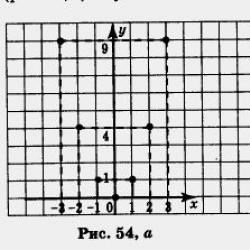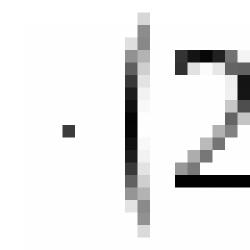Solution of linear equations with examples. Solution of equations with two variables Y 2 solution
In the 7th grade mathematics course, they first meet with equations with two variables, but they are studied only in the context of systems of equations with two unknowns. That is why a number of problems fall out of sight, in which certain conditions are introduced on the coefficients of the equation that limit them. In addition, methods for solving problems like “Solve an equation in natural or integer numbers” are also ignored, although problems of this kind are encountered more and more often in the USE materials and at entrance exams.
Which equation will be called an equation with two variables?
So, for example, the equations 5x + 2y = 10, x 2 + y 2 = 20, or xy = 12 are two-variable equations.
Consider the equation 2x - y = 1. It turns into a true equality at x = 2 and y = 3, so this pair of variable values is the solution to the equation under consideration.
Thus, the solution of any equation with two variables is the set of ordered pairs (x; y), the values of the variables that this equation turns into a true numerical equality.
An equation with two unknowns can:
A) have one solution. For example, the equation x 2 + 5y 2 = 0 has a unique solution (0; 0);
b) have multiple solutions. For example, (5 -|x|) 2 + (|y| – 2) 2 = 0 has 4 solutions: (5; 2), (-5; 2), (5; -2), (-5; - 2);
V) have no solutions. For example, the equation x 2 + y 2 + 1 = 0 has no solutions;
G) have infinitely many solutions. For example, x + y = 3. The solutions to this equation will be numbers whose sum is 3. The set of solutions to this equation can be written as (k; 3 - k), where k is any real number.
The main methods for solving equations with two variables are methods based on factoring expressions, highlighting the full square, using the properties of a quadratic equation, bounded expressions, and evaluation methods. The equation, as a rule, is transformed into a form from which a system for finding unknowns can be obtained.
Factorization
Example 1
Solve the equation: xy - 2 = 2x - y.
Solution.
We group the terms for the purpose of factoring:
(xy + y) - (2x + 2) = 0. Take out the common factor from each bracket:
y(x + 1) – 2(x + 1) = 0;
(x + 1)(y - 2) = 0. We have:
y = 2, x is any real number or x = -1, y is any real number.
Thus, the answer is all pairs of the form (x; 2), x € R and (-1; y), y € R.
Equality to zero of non-negative numbers
Example 2
Solve the equation: 9x 2 + 4y 2 + 13 = 12(x + y).
Solution.
Grouping:
(9x 2 - 12x + 4) + (4y 2 - 12y + 9) = 0. Now each parenthesis can be collapsed using the square difference formula.
(3x - 2) 2 + (2y - 3) 2 = 0.
The sum of two non-negative expressions is zero only if 3x - 2 = 0 and 2y - 3 = 0.
So x = 2/3 and y = 3/2.
Answer: (2/3; 3/2).
Evaluation method
Example 3
Solve the equation: (x 2 + 2x + 2) (y 2 - 4y + 6) = 2.
Solution.
In each bracket, select the full square:
((x + 1) 2 + 1)((y – 2) 2 + 2) = 2. Estimate  the meaning of the expressions in brackets.
the meaning of the expressions in brackets.
(x + 1) 2 + 1 ≥ 1 and (y - 2) 2 + 2 ≥ 2, then the left side of the equation is always at least 2. Equality is possible if:
(x + 1) 2 + 1 = 1 and (y - 2) 2 + 2 = 2, so x = -1, y = 2.
Answer: (-1; 2).
Let's get acquainted with another method for solving equations with two variables of the second degree. This method is that the equation is considered as square with respect to some variable.
Example 4
Solve the equation: x 2 - 6x + y - 4√y + 13 = 0.
Solution.
Let's solve the equation as a quadratic one with respect to x. Let's find the discriminant:
D = 36 - 4(y - 4√y + 13) = -4y + 16√y - 16 = -4(√y - 2) 2 . The equation will have a solution only when D = 0, i.e., if y = 4. We substitute the value of y into the original equation and find that x = 3.
Answer: (3; 4).
Often in equations with two unknowns indicate restrictions on variables.
Example 5
Solve the equation in integers: x 2 + 5y 2 = 20x + 2.
Solution.
Let's rewrite the equation in the form x 2 = -5y 2 + 20x + 2. The right side of the resulting equation, when divided by 5, gives a remainder of 2. Therefore, x 2 is not divisible by 5. But the square of a number that is not divisible by 5 gives a remainder of 1 or 4. Thus equality is impossible and there are no solutions.
Answer: no roots.
Example 6
Solve the equation: (x 2 - 4|x| + 5) (y 2 + 6y + 12) = 3.
Solution.
Let's select the full squares in each bracket:
((|x| – 2) 2 + 1)((y + 3) 2 + 3) = 3. The left side of the equation is always greater than or equal to 3. Equality is possible if |x| – 2 = 0 and y + 3 = 0. Thus, x = ± 2, y = -3.
Answer: (2; -3) and (-2; -3).
Example 7
For each pair of negative integers (x; y) satisfying the equation
x 2 - 2xy + 2y 2 + 4y = 33, calculate the sum (x + y). Answer the smallest amount.
Solution.
Select full squares:
(x 2 - 2xy + y 2) + (y 2 + 4y + 4) = 37;
(x - y) 2 + (y + 2) 2 = 37. Since x and y are integers, their squares are also integers. The sum of the squares of two integers, equal to 37, we get if we add 1 + 36. Therefore:
(x - y) 2 = 36 and (y + 2) 2 = 1 
(x - y) 2 = 1 and (y + 2) 2 = 36.
Solving these systems and taking into account that x and y are negative, we find solutions: (-7; -1), (-9; -3), (-7; -8), (-9; -8).
Answer: -17.
Do not despair if you have difficulties when solving equations with two unknowns. With a little practice, you will be able to master any equation.
Do you have any questions? Don't know how to solve equations with two variables?
To get the help of a tutor - register.
The first lesson is free!
site, with full or partial copying of the material, a link to the source is required.
An equation with one unknown, which, after opening the brackets and reducing like terms, takes the form
ax + b = 0, where a and b are arbitrary numbers, is called linear equation with one unknown. Today we will figure out how to solve these linear equations.
For example, all equations:
2x + 3 \u003d 7 - 0.5x; 0.3x = 0; x / 2 + 3 \u003d 1/2 (x - 2) - linear.
The value of the unknown that turns the equation into a true equality is called decision or the root of the equation .
For example, if in the equation 3x + 7 \u003d 13 we substitute the number 2 instead of the unknown x, then we get the correct equality 3 2 + 7 \u003d 13. Hence, the value x \u003d 2 is the solution or the root of the equation.
And the value x \u003d 3 does not turn the equation 3x + 7 \u003d 13 into a true equality, since 3 2 + 7 ≠ 13. Therefore, the value x \u003d 3 is not a solution or a root of the equation.
The solution of any linear equations is reduced to the solution of equations of the form
ax + b = 0.
We transfer the free term from the left side of the equation to the right, while changing the sign in front of b to the opposite, we get
If a ≠ 0, then x = – b/a .
Example 1 Solve the equation 3x + 2 =11.
We transfer 2 from the left side of the equation to the right side, while changing the sign in front of 2 to the opposite, we get
3x \u003d 11 - 2.
Let's do the subtraction, then
3x = 9.
To find x, you need to divide the product by a known factor, that is,
x = 9:3.
So the value x = 3 is the solution or the root of the equation.
Answer: x = 3.
If a = 0 and b = 0, then we get the equation 0x \u003d 0. This equation has infinitely many solutions, since when multiplying any number by 0, we get 0, but b is also 0. The solution to this equation is any number.
Example 2 Solve the equation 5(x - 3) + 2 = 3 (x - 4) + 2x - 1.
Let's expand the brackets:
5x - 15 + 2 \u003d 3x - 12 + 2x - 1.
5x - 3x - 2x \u003d - 12 - 1 + 15 - 2.
Here are similar members:
0x = 0.
Answer: x is any number.
If a = 0 and b ≠ 0, then we get the equation 0x = - b. This equation has no solutions, since when multiplying any number by 0, we get 0, but b ≠ 0.
Example 3 Solve the equation x + 8 = x + 5.
Let us group the terms containing unknowns on the left side, and the free terms on the right side:
x - x \u003d 5 - 8.
Here are similar members:
0x = - 3.
Answer: no solutions.
On figure 1 the scheme for solving the linear equation is shown
Let us compose a general scheme for solving equations with one variable. Consider the solution of example 4.
Example 4 Let's solve the equation
1) Multiply all terms of the equation by the least common multiple of the denominators, equal to 12.
2) After reduction we get
4 (x - 4) + 3 2 (x + 1) - 12 = 6 5 (x - 3) + 24x - 2 (11x + 43)
3) To separate members containing unknown and free members, open the brackets:
4x - 16 + 6x + 6 - 12 \u003d 30x - 90 + 24x - 22x - 86.
4) We group in one part the terms containing unknowns, and in the other - free terms:
4x + 6x - 30x - 24x + 22x \u003d - 90 - 86 + 16 - 6 + 12.
5) Here are similar members:
- 22x = - 154.
6) Divide by - 22 , We get
x = 7.
As you can see, the root of the equation is seven.
In general, such equations can be solved as follows:
a) bring the equation to an integer form;
b) open brackets;
c) group the terms containing the unknown in one part of the equation, and the free terms in the other;
d) bring similar members;
e) solve an equation of the form aх = b, which was obtained after bringing like terms.
However, this scheme is not required for every equation. When solving many simpler equations, one has to start not from the first, but from the second ( Example. 2), third ( Example. 13) and even from the fifth stage, as in example 5.
Example 5 Solve the equation 2x = 1/4.
We find the unknown x \u003d 1/4: 2,
x = 1/8 .
Consider the solution of some linear equations encountered in the main state exam.
Example 6 Solve equation 2 (x + 3) = 5 - 6x.
2x + 6 = 5 - 6x
2x + 6x = 5 - 6
Answer: - 0.125
Example 7 Solve the equation - 6 (5 - 3x) \u003d 8x - 7.
– 30 + 18x = 8x – 7
18x - 8x = - 7 +30
Answer: 2.3
Example 8 Solve the Equation

![]()
3(3x - 4) = 4 7x + 24
9x - 12 = 28x + 24
9x - 28x = 24 + 12
Example 9 Find f(6) if f (x + 2) = 3 7's
Solution
Since we need to find f(6), and we know f (x + 2),
then x + 2 = 6.
We solve the linear equation x + 2 = 6,
we get x \u003d 6 - 2, x \u003d 4.
If x = 4 then
f(6) = 3 7-4 = 3 3 = 27
Answer: 27.
If you still have questions, there is a desire to deal with the solution of equations more thoroughly, sign up for my lessons in the SCHEDULE. I will be glad to help you!
TutorOnline also recommends watching a new video tutorial from our tutor Olga Alexandrovna, which will help you understand both linear equations and others.
site, with full or partial copying of the material, a link to the source is required.
We will analyze two types of solving systems of equations:
1. Solution of the system by the substitution method.
2. Solution of the system by term-by-term addition (subtraction) of the equations of the system.
In order to solve the system of equations substitution method you need to follow a simple algorithm:
1. We express. From any equation, we express one variable.
2. Substitute. We substitute in another equation instead of the expressed variable, the resulting value.
3. We solve the resulting equation with one variable. We find a solution to the system.
To solve system by term-by-term addition (subtraction) need to:
1. Select a variable for which we will make the same coefficients.
2. We add or subtract the equations, as a result we get an equation with one variable.
3. We solve the resulting linear equation. We find a solution to the system.
The solution of the system is the intersection points of the graphs of the function.
Let us consider in detail the solution of systems using examples.
Example #1:
Let's solve by the substitution method
Solving the system of equations by the substitution method2x+5y=1 (1 equation)
x-10y=3 (2nd equation)
1. Express
It can be seen that in the second equation there is a variable x with a coefficient of 1, hence it turns out that it is easiest to express the variable x from the second equation.
x=3+10y
2. After expressing, we substitute 3 + 10y in the first equation instead of the variable x.
2(3+10y)+5y=1
3. We solve the resulting equation with one variable.
2(3+10y)+5y=1 (open brackets)
6+20y+5y=1
25y=1-6
25y=-5 |: (25)
y=-5:25
y=-0.2
The solution of the equation system is the intersection points of the graphs, therefore we need to find x and y, because the intersection point consists of x and y. Let's find x, in the first paragraph where we expressed we substitute y there.
x=3+10y
x=3+10*(-0.2)=1
It is customary to write points in the first place, we write the variable x, and in the second place the variable y.
Answer: (1; -0.2)
Example #2:
Let's solve by term-by-term addition (subtraction).
Solving a system of equations by the addition method3x-2y=1 (1 equation)
2x-3y=-10 (2nd equation)
1. Select a variable, let's say we select x. In the first equation, the variable x has a coefficient of 3, in the second - 2. We need to make the coefficients the same, for this we have the right to multiply the equations or divide by any number. We multiply the first equation by 2, and the second by 3 and get a total coefficient of 6.
3x-2y=1 |*2
6x-4y=2
2x-3y=-10 |*3
6x-9y=-30
2. From the first equation, subtract the second to get rid of the variable x. Solve the linear equation.
__6x-4y=2
5y=32 | :5
y=6.4
3. Find x. We substitute the found y in any of the equations, let's say in the first equation.
3x-2y=1
3x-2*6.4=1
3x-12.8=1
3x=1+12.8
3x=13.8 |:3
x=4.6
The point of intersection will be x=4.6; y=6.4
Answer: (4.6; 6.4)
Do you want to prepare for exams for free? Tutor online for free. No kidding.






